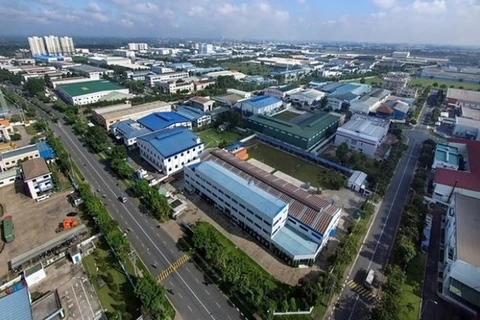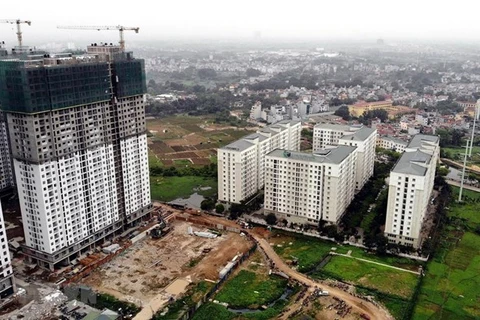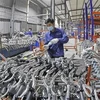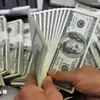 The realty sector records a strong rise in the value of corporate bonds issued in the first six months of 2021 (Illustrative photo: VNA)
The realty sector records a strong rise in the value of corporate bonds issued in the first six months of 2021 (Illustrative photo: VNA) In the second quarter of 2021, the total value of corporate bonds issued reached 164 trillion VND (7.15 billion USD), 3.7 times higher than the previous quarter and up 29 percent over the same period in 2020, according to the corporate bond market report published recently by the Center for Analysis and Investment Advisory of SSI Securities Joint Stock Company (SSI Research).
Of the estimate, the value of bonds issued by real estate enterprises was 64.4 trillion VND, accounting for 44.4 percent of the total issued value, an increase of 131 percent compared to the previous quarter and an increase of 285 percent over the same period in 2020.
The issuers with the largest amounts of bonds were Golden Hill, BIM Group, Hung Thinh Quy Nhon and Wonderland. Besides domestic issuance, a number of businesses also issued international bonds, such as BIM Group issuing 200 million USD with an interest rate of 7.4 percent per year.
In the first two quarters of 2021, real estate businesses issued the largest amount of bonds with the issuance value of up to 92.3 trillion VND, with an average interest rate of 10.36 percent per year, 23 percentage points lower than the 2020 average.
“The main fuel of the bond market in the real estate sector is that bond interest rates are much higher than deposit rates at banks, as well as current restrictions on access to bank capital," said the report by SSI Research.
A reporter from tinnhanhchungkhoan.vn, posing as an individual investor, tried to buy bonds in a group on Facebook, with an expected investment of several hundred million Vietnamese dong, he received dozens of messages thereafter.
Decree No 153/2020/ND-CP on private bond offering and trading, effective from January 1, 2021, stipulates that buyers of privately issued bonds must be professional investors. But in fact, brokerages can still commit a breach of this regulation if customers insist.
Huong Nguyen, a financial consultant working at a securities company, told tinnhanhchungkhoan.vn her company was ready to support customers in the procedures and conditions to possess a certificate as a professional investor if that buyer wishes to directly sign the bond purchase contract.
Huong said that the bonds provided by the company have many terms for customers to choose from, particularly 3-6-9-12-15 months, with interest rates amounting to 10 percent per year, significantly higher than the interest rates offered by banks for deposits.
“Lower bank interest rates and current volatile stock market are attributed to investors more frequently shifting to other investment channels such as corporate bonds,” said Nguyen Anh Trung, Deputy General Director of the Hai Phong Securities Company.
“The outbreak of the COVID-19 pandemic, however, is damaging the production and business activities of enterprises, affecting their ability to pay interest for bonds.
“Recently there are businesses in the field of beauty, car repair and maintenance, karaoke and restaurants, which are non-essential services and businesses easily affected by the disease, regularly inviting individual investors to buy corporate bonds with unbelievably high interest rates of 18 percent per year for an investment of only 1 billion VND,” he said.
In the latest warning, the Ministry of Finance said that investors buying bonds need to clearly distinguish between the two methods of issuing corporate bonds to the public, and issuing corporate bonds privately.
Increased risk
SSI Research forecast in its report that risks with corporate bonds are increasing, especially in the real estate and energy sectors.
According to SSI Research, of the bonds issued in the first half of 2021, 18.6 percent are secured by real estate, 11 percent are secured by assets, 33 percent are partially secured by assets, real estate and shares, 9.3 percent fully secured by shares and 28 percent unsecured.
More specifically, the report stated that there is 29 trillion VND of real estate bonds fully secured by stocks or without collateral. If including real estate bonds partially secured by shares, this figure reaches nearly 60 trillion VND, accounting for 64 percent of the total amount of real estate bonds issued in the first six months of 2021.
The obligation to pay the bond interests by shares is meaningless because when a crisis occurs, the enterprise becomes insolvent, the value of shares used as collateral also drops dramatically, SSI said./.
VNA























